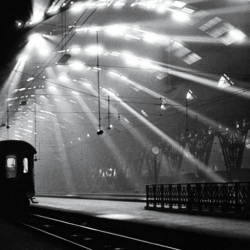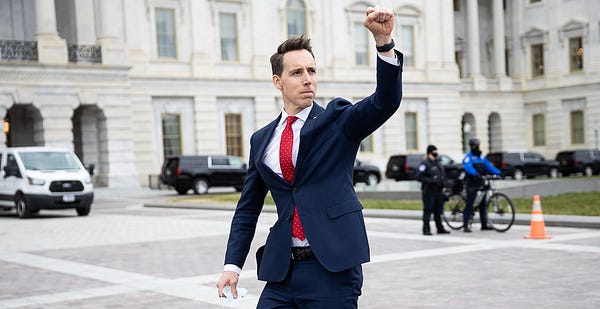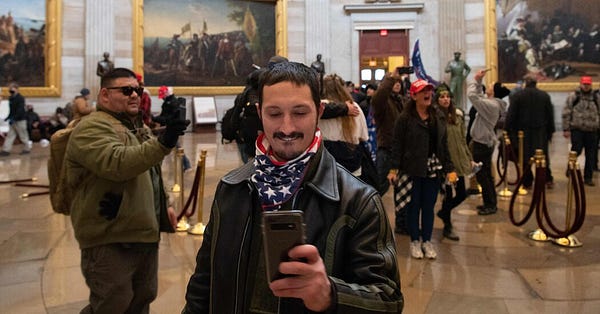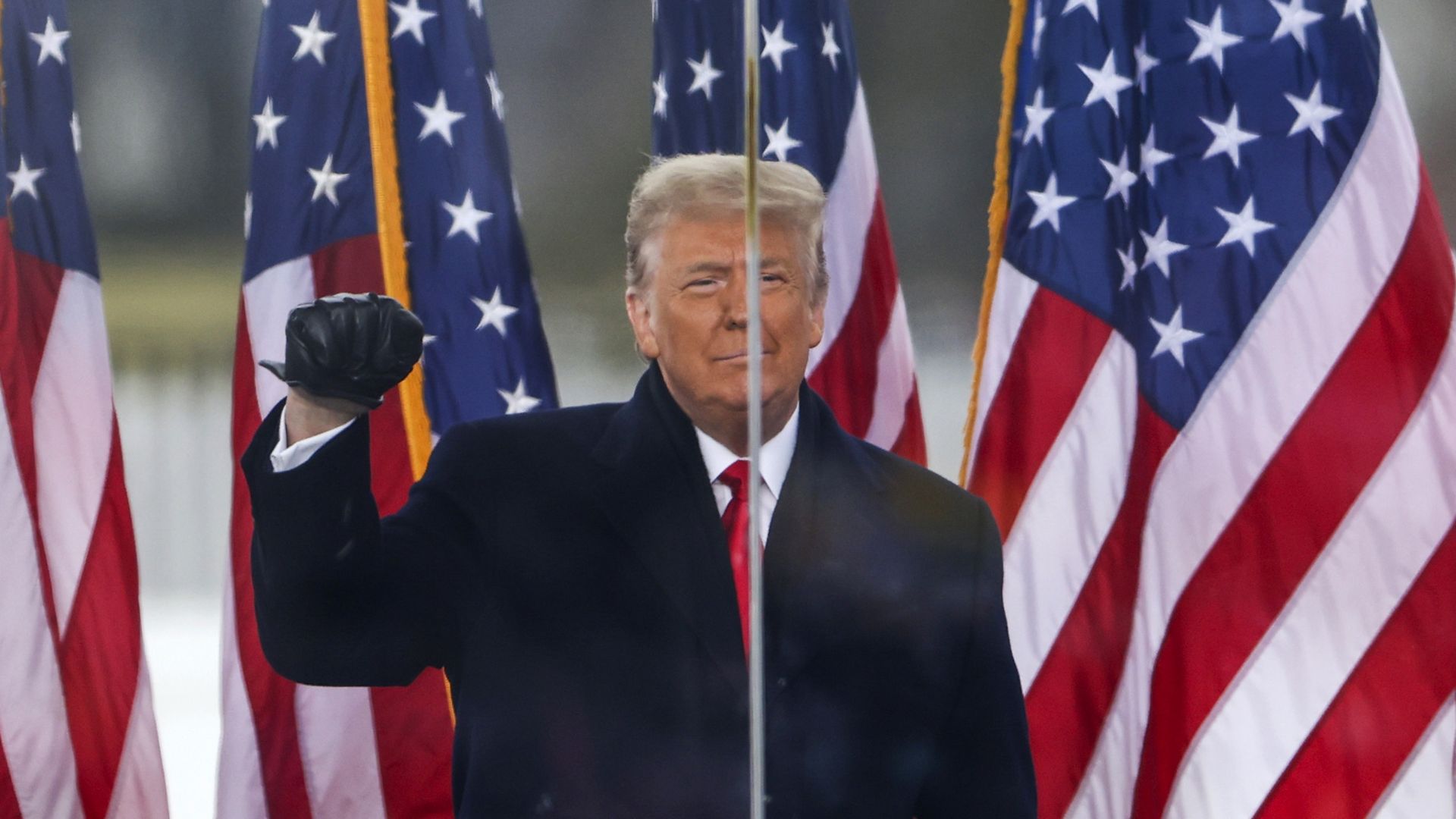
Congress Reconvenes After Pro-Trump Mob Brings Chaos To The Capitol

A pro-Trump mob breaks into the U.S. Capitol.Win McNamee/Getty Images
Updated at 11:45 p.m. ET
Congress reconvened Wednesday night to certify President-elect Joe Biden’s Electoral College victory, just hours after the U.S. Capitol was thrust into chaos by supporters of President Trump — an angry mob that breached the complex in an unprecedented violent act at the seat of America’s federal government.
Earlier in the day, the president has urged his backers to head to the Capitol.
A woman was shot and killed during the assault, according to Washington, D.C., police. Her identity has not been made public.
A law enforcement official familiar with the investigation told NPR’s Carrie Johnson that the alleged shooter of the woman was a senior U.S. Capitol Police officer and that the woman who was killed was unarmed.
D.C. police said three other adults died after suffering from apparent medical emergencies.

A rioter holds a Trump flag inside the U.S. Capitol Building near the Senate Chamber.Win McNamee/Getty Images

U.S. Capitol Police try to hold back rioters outside the east doors to the House side of the U.S. Capitol.Andrew Harnik/AP

Rioters are confronted by Capitol Police officers outside the Senate Chamber.Manuel Balce Ceneta/AP

A rioter sits in the Senate Chamber.Win McNamee/Getty Images

Demonstrators breached security and entered the Capitol on Wednesday as Congress debated the 2020 electoral vote tally.Roberto Schmidt/AFP via Getty Images
The insurrectionists interrupted proceedings in the House and Senate Wednesday afternoon as members of Congress were tallying Biden’s win. The counting of the electoral votes is normally a relatively pro forma session.
But for two months, Trump has falsely and continuously claimed the election was stolen from him, and dozens of fellow Republican allies had planned to object to slates of electors from various states they considered contested.
Lawmakers were debating an objection to Arizona’s results — a swing state Trump lost narrowly — when the sessions were recessed as the Capitol Police attempted to put the complex on lockdown.
Violent protesters were seen smashing windows and occupying the House and Senate floors and various lawmakers’ offices. Police were seen with guns drawn in the House chamber, pointing their firearms at windows that were smashed.

Police with guns drawn face off with protesters trying to break into the House chamber Wednesday at the Capitol.J. Scott Applewhite/AP

Rep. Jason Crow, D-Colo., comforts Rep. Susan Wild, D-Pa., while taking cover as rioters disrupt the joint session of Congress to certify the Electoral College vote.Tom Williams/CQ-Roll Call, Inc via Getty Images

People shelter in the House gallery as rioters try to break into the House Chamber.Andrew Harnik/AP

Papers and other equipment after the House floor was evacuated as rioters tried to break into the House Chamber.J. Scott Applewhite/AP
People inside the building were told to shelter in place, and congressional leaders were taken off-site. Members of Congress were told that tear gas was being used in the Capitol Rotunda and that they should get ready to put on masks.
D.C. police said there were approximately 52 arrests as of 9:30 pm. ET, and that 14 police officers were injured.
The city’s mayor, Muriel Bowser, said Wednesday night a review will begin immediately to determine how security at the Capitol was compromised.
Trump urges peace but doubles down on election falsehoods
On Twitter, Trump asked people to remain peaceful. He then posted a video on social media, asking the rioters to go home — but not before reiterating his baseless claims about the election being stolen and saying: “You’re very special.”
Twitter and Facebook acted to remove the video, and Twitter said it locked Trump’s account for 12 hours.
His response to the violence came a few hours after he spoke to thousands of supporters outside the White House, in which he repeatedly denied the results of the election, claiming without evidence it was rigged against his campaign.
“This election was stolen from you, from me, from the country,” he said in the earlier remarks. He also urged his supporters to head to the Capitol, adding: “You’ll never take back our country with weakness.”

Protesters gesture to U.S. Capitol Police in the hallway outside of the Senate chamber on Wednesday.Manuel Balce Ceneta/AP

A rioter sits inside the office of House Speaker Nancy Pelosi inside the U.S. Capitol.Saul Loeb/AFP via Getty Images
Federal and local authorities scrambled to send forces to help secure the Capitol after it was overrun by the pro-Trump extremists. Reinforcements were also being deployed from Virginia, Maryland and New Jersey.
PROTESTS HALT CONGRESS’ ELECTORAL COUNT:
Authorities Send Reinforcements To Help Secure The Capitol
Law enforcement eventually gained control of the scene, ushering people out of the Capitol. The House sergeant at arms informed lawmakers and staff after 5 p.m. that the Capitol had been cleared.
Washington, D.C., instituted a 12-hour curfew that went into effect at 6 p.m. ET Wednesday.
“The President bears responsibility”
Many Republicans, who spent the summer castigating the mostly peaceful protests against racial police violence, had previously encouraged demonstrations calling to overturn the democratic election results.
But current and former politicians from both major parties condemned the breach of the Capitol, with Democrats and many Republicans blaming Trump and his allies for inciting the mob through their repeated claims of a stolen election.
Election Officials Warned ‘Someone’s Going To Get Shot,’ But That Didn’t Stop Trump
The Democrat Biden said of the attack on the Capitol: “It’s not protest; it’s insurrection.” And he urged the president to “go on national television now to fulfill his oath and defend the Constitution and demand an end to this siege.”
PROTESTS HALT CONGRESS’ ELECTORAL COUNT:
Biden: Democracy ‘Under Unprecedented Assault’ As Pro-Trump Extremists Occupy Capitol
PROTESTS HALT CONGRESS’ ELECTORAL COUNT:
“History will rightly remember today’s violence at the Capitol, incited by a sitting president who has continued to baselessly lie about the outcome of a lawful election, as a moment of great dishonor and shame for our nation,” former President Barack Obama said in a statement. “But we’d be kidding ourselves if we treated it as a total surprise. For two months now, a political party and its accompanying media ecosystem has too often been unwilling to tell their followers the truth — that this was not a particularly close election and that President-Elect Biden will be inaugurated on January 20.”
Former President George W. Bush, a Republican, said he was “appalled” by the actions of some political leaders since the election and called the “mayhem” at the Capitol “a sickening and heartbreaking sight.”
“This is how election results are disputed in a banana republic — not our democratic republic,” Bush wrote in a statement released Wednesday evening.
“The President bears responsibility for today’s events by promoting the unfounded conspiracy theories that have led to this point,” Sen. Richard Burr, R-N.C., said in a statement. “It is past time to accept the will of American voters and to allow our nation to move forward.”
Sen. Mitt Romney, R-Utah, a frequent critic of Trump, described the breach of the U.S. Capitol as “an insurrection, incited by the president of the United States.”

Trump supporters try to break through a police barrier during protests Wednesday at the Capitol.Julio Cortez/AP

A rioter carries a Confederate battle flag on the second floor of the U.S. Capitol near the entrance to the Senate after breaching security defenses.Mike Theiler/Reuters
Sen. Ben Sasse, a Republican from Nebraska, in a statement described the Capitol as being “ransacked while the leader of the free world cowered behind his keyboard.”
He continued: “Lies have consequences. This violence was the inevitable and ugly outcome of the President’s addiction to constantly stoking division.”
Other Republicans who pledged to object to electoral vote slates refrained from implicating Trump, focusing instead on quelling the violence of his supporters.
CONGRESS RECONVENES AFTER INSURRECTION:
Twitter Locks Trump’s Account, Warns Of ‘Permanent Suspension’ If Violations Continue
“Those storming the Capitol need to stop NOW,” Sen. Ted Cruz of Texas wrote on Twitter. “The Constitution protects peaceful protest, but violence—from Left or Right— is ALWAYS wrong. And those engaged in violence are hurting the cause they say they support.”
“You did not win”
Despite the violent breach, Congress resumed its session Wednesday night.
“To those who wreaked havoc in our Capitol today, you did not win,” Vice President Pence, in his role as president of the Senate, said as he gaveled the proceedings back in. “Violence never wins, freedom wins. And this is still the people’s house.”
POLITICS
Democrats Take Control Of Senate With Twin Georgia Victories
Earlier, House Speaker Nancy Pelosi, D-Calif., wrote in a letter to members that the “shameful assault” on democracy wouldn’t “deter us from our responsibility to validate the election of Joe Biden.”
The attack on the Capitol convinced some GOP senators, including Steve Daines of Montana and Mike Braun of Indiana, to withdraw their objections to electoral votes.
Georgia Sen. Kelly Loeffler, who just lost her reelection bid, said she will no longer object to the state’s results.
“The events that have transpired today have forced me to reconsider and I cannot now in good conscious object to the certification of these electors,” she said.
Earlier Wednesday, Sen. Jeff Merkley, D-Ore., wrote on Twitter that the Electoral College ballots had been “rescued from the Senate floor. If our capable floor staff hadn’t grabbed them, they would have been burned by the mob.”
NPR’s Deirdre Walsh, Kelsey Snell and Brian Mann contributed to this report.




 At 4:17, Trump issued his own video, reiterating his false claims that he had been cheated of victory. Only then did he conclude with: “Go home, we love you, you’re very special.” Twitter immediately took the video down. By nighttime Trump’s Twitter feed seemed to blame his enemies for the violence the president had incited (although the rhythm of the words did not sound to me like Trump’s own usual cadence): “These are the things and events that happen when a sacred landslide election victory is so unceremoniously & viciously stripped away from great patriots who have been badly & unfairly treated for so long. Go home with love & in peace. Remember this day forever!”
At 4:17, Trump issued his own video, reiterating his false claims that he had been cheated of victory. Only then did he conclude with: “Go home, we love you, you’re very special.” Twitter immediately took the video down. By nighttime Trump’s Twitter feed seemed to blame his enemies for the violence the president had incited (although the rhythm of the words did not sound to me like Trump’s own usual cadence): “These are the things and events that happen when a sacred landslide election victory is so unceremoniously & viciously stripped away from great patriots who have been badly & unfairly treated for so long. Go home with love & in peace. Remember this day forever!”







 Notes: All polls are of registered voters. CNN’s poll was conducted by ORC in 2016 and SSRS in 2020. Marist’s 2016 media partner was McClatchy, and its partners are NPR and PBS NewsHour in 2020. CNN, Marist, and Pew polls used here in both 2016 and 2020 only named the major party candidates. The Monmouth polls in both 2016 and 2020 included the Libertarian and Green Party nominees by name. Columns may not add up to 100% because of rounding.
Notes: All polls are of registered voters. CNN’s poll was conducted by ORC in 2016 and SSRS in 2020. Marist’s 2016 media partner was McClatchy, and its partners are NPR and PBS NewsHour in 2020. CNN, Marist, and Pew polls used here in both 2016 and 2020 only named the major party candidates. The Monmouth polls in both 2016 and 2020 included the Libertarian and Green Party nominees by name. Columns may not add up to 100% because of rounding.





/cdn.vox-cdn.com/uploads/chorus_image/image/67218186/AP_20231068243361.0.jpg)





 A residency requirement for NYPD officers has been debated over the years, with state Senator Kevin Parker [above]
A residency requirement for NYPD officers has been debated over the years, with state Senator Kevin Parker [above]